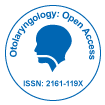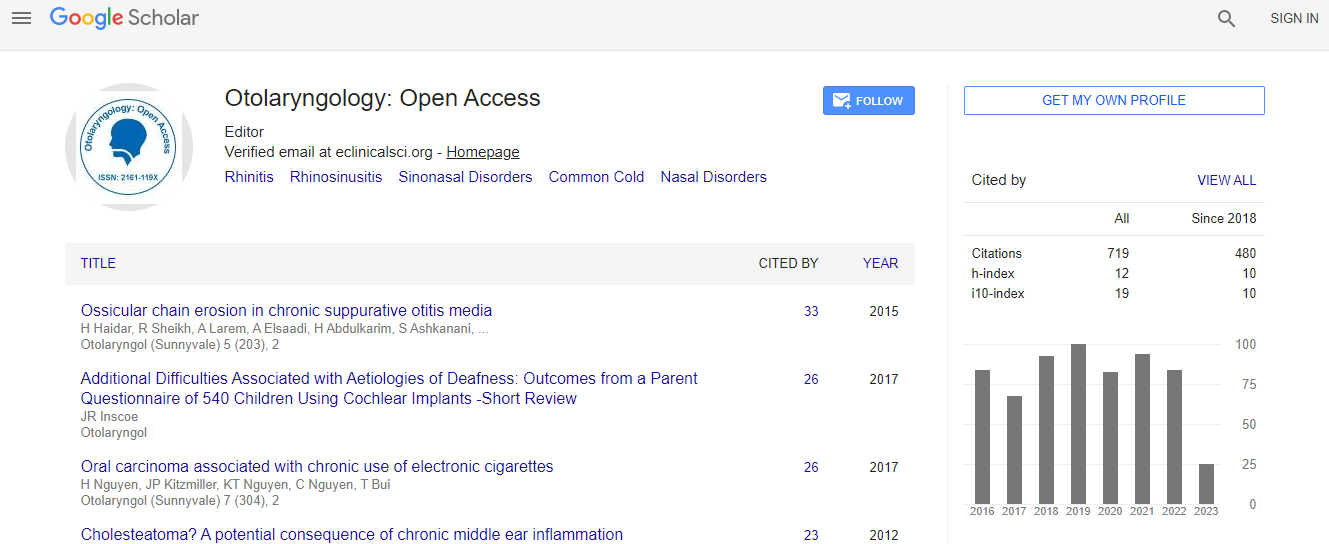Our Group organises 3000+ Global Conferenceseries Events every year across USA, Europe & Asia with support from 1000 more scientific Societies and Publishes 700+ Open Access Journals which contains over 50000 eminent personalities, reputed scientists as editorial board members.
Open Access Journals gaining more Readers and Citations
700 Journals and 15,000,000 Readers Each Journal is getting 25,000+ Readers
Google Scholar citation report
Citations : 925
Otolaryngology: Open Access received 925 citations as per Google Scholar report
Otolaryngology: Open Access peer review process verified at publons
Indexed In
- Index Copernicus
- Google Scholar
- Sherpa Romeo
- Open J Gate
- Genamics JournalSeek
- RefSeek
- Hamdard University
- EBSCO A-Z
- OCLC- WorldCat
- Publons
- Geneva Foundation for Medical Education and Research
- ICMJE
Useful Links
Recommended Journals
Related Subjects
Share This Page
Speech-Therapy Performance with Laryngomalacia patients
Joint Event on 4th European Otolaryngology-ENT Surgery Conference & 3rd International Conference on Craniofacial Surgery
Roseane Rebelo S. Meira
University of Campinas, Brazil
Posters & Accepted Abstracts: Otolaryngol (Sunnyvale)
Abstract
Introduction: The dysphagia is a symptom that is characterized by the difficulty in the bolus transit between the mouth and stomach, which may cause deviations in this path, with obstruction or not of the respiratory passages. The causes that affect the coordination sucking-swallowing-breathing are numerous. Among these causes of pediatric dysphagia there are the abnormalities of the upper airway, as the laryngomalacia (LM). The LM is a laryngeal malformation that affects the supraglottic area and is characterized by the colapse of the laryngeal supraglottic structures, epiglottis, arytenoid mucosa and aryepiglottic folds during the inhalation. This is the most commom cause for childhood laryngeal rattling (50 to 70%) and the biggest cause for larynx congenital abnormality. The LM diagnosis is accomplished through a nasofibrolaryngoscop exam, carried out by the otolaryngologist that detects the characteristic abnormalities, besides excluding other pathologies. The symptoms should disappear between 18 – 24 months and 10% of the cases need surgical treatment. Besides the rattling, patients with LM can present alimentary difficulties, with weight gain, dysphagia, aspiration, apnea, cyanosis, gastro-oesophageal reflux, obstructive sleep apnea and, in the severe cases, pulmonar hypertension. The gastro-oesophageal reflux disease is an important comorbidity of LM. The LM cause is not clear yet. Nowadays, the most accepted theory suggests that children with LM perform an alteration of the laryngeal tônus and of the integrative function sensorimotor. The LM is classified in three degrees: slight, mild and severe, and it’s based only on the symptomatic performance. In slight cases only the rattling is involved. As to the mild cases, it also occurs chokes and alimentary difficulties. During the swallowing occurs the interruptions of breathing. Therefore children with airway impairment or others respiratory difficulties may not be able to safely coordinate the suction, swallow and breath functions, leading into a dysphagia and a possible aspiration. In these cases, it’s possible to exist cough, chokes, cyanosis and respiratory sounds, which can be related to the laryngotracheal penetration or aspiration. There is also the possibility of having an increased time in the ingestion of food and difficulty in weight gain.Objective: To emphasize the necessity of speech therapy assistance in the LM cases.
Method: The evaluation of swallowing is held according to the symptoms, clinical evaluations of swallowing carried by a speech therapist and instrumental studies of objective evaluations of swallowing, including VF and VED. In the LM cases, 50,3% of the patients report dysphagia symptoms or alimentary difficulties and 9,6% of the patients have difficulty in weight gain. When these patients are clinically evaluated and with complementary exams, this incidence increases, thus suggesting cases of silent aspiration.
Result: The main objective of the speech-therapy intervention in these cases is to promote a safe feeding, efficient and pleasant. In this regard, it is necessary to have a therapy with the focus on orofacial motricity aiming to have an adequacy of the orofacial musculature (sensitivity, tonus and force) and its orofacial functions, therefore improving the standard of sucking-swallowing-breathing. Besides that, in some cases it is necessary to make an adaptation of consistencies and tools to improve the control of the flow and of the food volume.
Biography
Dr Roseane Rebelo S. Meira is a speechtherapist specialized in swallowing disorders with several international courses. She has been seeing baby pacients for 27 years with large experience in breastfeeding and cheewing issues. She has been teaching in neonatology courses for speechtherapists for 15 years, contributing to the training of new professionals.

 Spanish
Spanish  Chinese
Chinese  Russian
Russian  German
German  French
French  Japanese
Japanese  Portuguese
Portuguese  Hindi
Hindi 
